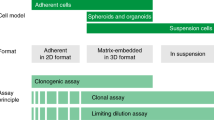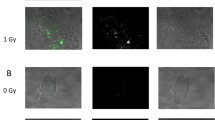Summary
Five human glioblastomas maintained in an organ culture system were studied by autoradiography to determine, after 8 days in vitro, the growth fraction (GF) of the explants, their total cell cycle time (T C) and cell cycle phase durations (T S,T G1,T G2 andT M), and their potential doubling time (T pot) after pulse-labeling with [3H] TdR for 1 h. These parameters were derived from computer analysis of fraction of labeled mitoses (FLM) curves. The results fell into two groups.
In two tumors, the cultures had a GF of 0.25 and 0.23. From the FLM curves were derived aT C of 89 and 83 h, aT S of 16.5 and 9.5 h, and aT G1 of 60 and 61 h.T M was estimated at 0.9 and 0.6 h, andT G2 12h. TheT pot was 12 days. These values approximate those reported for glioblastomas and other human malignancies in vivo.
The explants of three other glioblastomas gave different FLM curves: the derivedT S were increased to 36 and 55 h, estimatedT M ranged from 2.4 to 4.5 h, andT G2 ranged from 11 to 20 h.T C andT G1 could not be estimated. In two tumors the GF was reduced to 0.12 and 0.11, with aT pot of respectively 52 and 39 days. These values are comparable to those reported for astrocytomas of intermediate malignancy. In the third tumor, the GF was only 0.014. The reduction in GF and the lengthening of cell cycle components in this group of explants are similar to the kinetic changes reported in some in vivo tumors and three-dimensional in vitro systems that have reached a plateau stage of growth. They are probably related to the greater opportunities for cell-to-cell contacts and the resulting increased differentiation favored by the organ culture technique.
Similar content being viewed by others
References
Berry RJ, Hall EJ, Cavanagh JB (1970) Radiosensitivity and the oxygen effect for mammalian cells cultured in vitro in stationary phase. Br J Radiol 43:81–90
Bissell MG, Eng LF, Herman MM, Bensch KG, Miles LEM (1975) Quantitative increase of neuroglia-specific GFA protein in rat C-6 glioma cells in vitro. Nature 225:633–634
Burton AC (1966) Rate of growth of solid tumors as a problem of diffusion. Growth 30:157–176
Carlsson J (1977) A proliferation gradient in three-dimensional colonies of cultured human glioma cells. Int J Cancer 20:129–136
Durand RE, Sutherland RM (1973) Growth and radiation survival characteristics of V79-171b Chinese hamster cells: a possible influence of intercellular contact. Rad Res 56:513–527
Eng LF, Rubinstein LJ (1978) Contribution of immunohistochemistry to diagnostic problems of human cerebral tumors. J Histochem Cytochem 26:513–522
Féaux de Lacroix W, Lennartz KJ (1982) Changes in the proliferation characteristics of a solid transplantable tumour of the mouse with time after transplantation. Cell Tissue Kinet 14:135–142
Fell HB, Martinovitch PN, Gaillard PJ (1951) Methods for study of organized growth in vitro. Methods Med Res 4:233–246
Fell HB, Robison R (1929) The growth, development and phosphatase activity of embryonic avian femora and limb-buds cultivated in vitro. J Biochem 23:767–784
Hahn GM, Little JB (1972) Plateau phase cultures of mammalian cells: an in vitro model for human cancer. Curr Top Rad Res Q 8:39–83
Hahn GM, Stewart JR, Yang S-J, Parker V (1968) Chinese hamster cell monolayer cultures. I. Changes in cell dynamics and modifications of the cell cycle with the period of growth. Exp Cell Res 49:285–292
Halks-Miller M, Miller RG, Rubinstein LJ (1981) Rat C-6 glioma cells maintained in an organ culture system: a study of kinetic parameters. Cell Tissue Kinet 14:59–72
Hoshino T, Barker M, Wilson CB, Boldrey EB, Fewer D (1972) Cell kinetics of human gliomas. J Neurosurg 37:15–26
Hoshino T, Wilson CB (1979) Cell kinetic analysis of human malignant brain tumors (gliomas). Cancer 44:956–962
Hoshino T, Wilson CB, Muraoka I (1979) The stathmokinetic (mitostatic) effect of vincristine and vinblastine on human gliomas. Acta Neuropathol (Berl) 47:21–25
Hoshino T, Wilson CB, Rosenblum ML, Barker M (1975) Chemotherapeutic implications of growth fraction and cell cycle time in glioblastomas. J Neurosurg 43:127–135
Kalus M, Ghidoni JJ, O'Neal RM (1968) The growth of tumors in matrix cultures. Cancer 22:507–510
Leighton J, Tchao R (1975) Metabolic gradients in tissue culture studies. In: Pogh J (ed) Human tumor cells in vitro. Plenum Press, New York, pp 241–265
Liao CL, Eng LF, Herman MM, Bensch KG (1978) Glial fibrillary acidic protein — solubility characteristics, relation to cell growth phases and cellular localization in rat C-6 glioma cells: an immunoradiometric and immunohistologic study. J Neurochem 30:1181–1186
Liao CL, Herman MM, Bensch KG (1978) Prolongation of G1 and S phase in C-6 glioma cells treated with maple syrup urine disease metabolites. Morphologic and cell cycle studies. Lab Invest 38:122–133
Mendelsohn MI, Dohan FC, Moore HA (1960) Autoradiographic analysis of cell proliferation in a spontaneous breast cancer of C3H mouse. I. Typical cell cycle and timing of DNA synthesis. J Natl Cancer Inst 25:477–484
Nederman T, Carlsson J, Malmquist M (1981) Penetration of substances into tumor tissue — a methodological study on cellular spheroids. In Vitro: 17:290–298
Potmesil M, Goldfeder A (1980) Cell kinetics of irradiated experimental tumors: cell transition from the non-proliferating to the proliferating pool. Cell Tissue Kinet 13:563–570
Röller M-R, Owen SP, Heidelberger C (1966) Studies on the organ culture of human tumors. Cancer Res 26:626–637
Rosentraus MJ, Sundell CL, Liskay RM (1982) Cell-cycle characteristics of undifferentiated and differentiating embryonal carcinoma cells. Dev Biol 89:516–520
Rubinstein LJ, Herman MM (1975) Studies on the differentiation of human and experimental gliomas in organ culture systems. Rec Results Cancer Res 51:35–51
Rubinstein LJ, Herman MM, Foley VL (1973) In vitro characteristics of human glioblastomas maintained in organ culture systems. Light microscopy observations. Am J Pathol 71: 61–80
Sipe JC, Herman MM, Rubinstein LJ (1973) Electron microscopic observations on human glioblastomas and astrocytomas maintained in organ culture systems. Am J Pathol 73:589–606
Sipe JC, Rubinstein LJ, Herman MM, Bignami A (1974) Ethylnitrosourea-induced astrocytomas: morphologic observations on rat tumors maintained in tissue and organ culture systems. Lab Invest 31:571–579
Steel GG (1968) Cell loss from experimental tumours. Cell Tissue Kinet 1:193–207
Steel GG (1977) Growth kinetics of tumors. Cell population kinetics in relation to the growth and treatment of cancer. Clarendon Press, Oxford
Steel GG (1980) Growth kinetics of brain tumours. In: Thomas DGT, Graham DI (eds) Brain tumours. Scientific basis, clinical investigation and current therapy. Butterworths, London, pp 10–20
Sutherland RM, McCredie JA, Inch WR (1971) Growth of multicell spheroids in tissue culture as a model of nodular carcinomas. J Natl Cancer Inst 46:113–120
Takahashi M, Hogg JD, Mendelsohn ML (1971) The automatic analysis of FLM curves. Cell Tissue Kinet 4:505–518
Tannock I (1968) The relation between cell proliferation and the vascular system in a transplanted mouse mammary tumour. Br J Cancer 22:258–273
Tannock IF (1969) A comparison of cell proliferation parameters in solid and ascites Ehrlich tumors. Cancer Res 29:1527–1534
Trowell OA (1959) The culture of mature organs in a synthetic medium. Exp Cell Res 16:118–147
Wibe E, Lindmo T, Kaalhus O (1981) Cell kinetic characteristics in different parts of multicellular spheroids of human origin. Cell Tissue Kinet 14:639–651
Author information
Authors and Affiliations
Additional information
Supported by Research Grant CA-31271 (LJR) from the National Cancer Institute, by Graduate Neuropathology Research Training Grant 5T32 NS 7111 (LJR) from the National Institute of Neurological and Communicative Diseases and Stroke, USPHS, and by an R. S. McLaughlin Foundation Fellowship Award (JM)
Rights and permissions
About this article
Cite this article
Hess, J.R., Michaud, J., Sobel, R.A. et al. The kinetics of human glioblastomas maintained in an organ culture system. Acta Neuropathol 61, 1–9 (1983). https://doi.org/10.1007/BF00688379
Received:
Accepted:
Issue Date:
DOI: https://doi.org/10.1007/BF00688379




